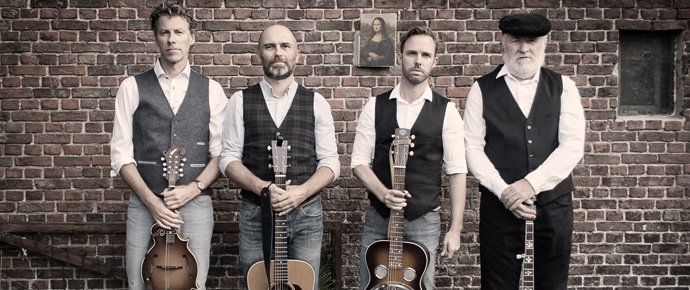
For the past five years, the M-City Ramblers have made it their mission to help establish a bastion for bluegrass in Belgium. Nevertheless, its evolution came naturally. The band played its first official gig at a regional contest for acoustic music in early 2016. Although they didn’t win, they received enough of an enthusiastic response to give them incentive to continue, which they’ve done by playing at least monthly ever since. The group’s repertoire consists of covers, but they adhere to tradition by singing around a single mic and emphasizing acoustic instrumentation. The tack’s done well for them, having secured them performances at the Low Country Bluegrass Festival in their native Belgium and at the La Roche Bluegrass Festival, taking place in France.
The members of M-City Ramblers — Jef Fockaert (banjo, vocals), Geert Dignef (guitar, vocals), Maarten Rummens (dobro, lead vocals), Tom Broekmans (mandolin, vocals) — played separately in various bands prior to initially joining forces in 2015. Fockaert had performed in traditional Irish and bluegrass bands since the ’80s. Rummens began performing bluegrass in 2010 courtesy of a country/blues/bluegrass band that Dignef was also a part of. And while the other members of the outfit claim varied musical backgrounds, none of them have any formal musical training aside from Dignef, a high school music teacher.
“We’re all more or less self-taught,” Broekmans says.
Fockaert says his interest in bluegrass was triggered by the folk boom that gained strength in Europe during the 1970’s. “Clubs and cafés started organizing small scale acoustic concerts,” he recalls. “That’s how I got to see some of the first Belgian bluegrass bands, like The Nuyens Family (who later went to live in the US) and a group called Smoketown Strut. The people from those bands managed to bring some American old-time bluegrass protagonists to Belgium, and that’s how I got to see people like Bill Keith, Tracy and Eloise Schwartz, Tom Paley, Peggy Seeger, Art Rosenbaum, Joe Val, Bill Clifton, Byron Berline, and The Country Gentlemen back in those days. I also got to see Jim and Jesse, Doc Watson, and Tony Trischka. Those people formed my musical taste.”
He adds that Earl Scruggs also had a profound influence on his banjo playing.
Although Fockaert is the oldest member of the band, Broekmans says that the rest of the band coalesced around the same musical ideals. “We’re about 20 years younger than Jef, but there has never been a generational conflict in the band so far,” he insists. “Still, Maarten’s, Geert’s, and my bluegrass history doesn’t go back as far as his.”
Rummens says it was his visit to the La Roche festival in 2018 that inspired his initial interest in the banjo, the dobro, and the sounds of traditional bluegrass. “My dobro playing is influenced by Andy Hall and Josh Graves,” he says. “I also love Uncle Josh’s bluesy style. My other influences are Rob Ickes and Andy Hall, of course.”
Dignef recalls that he first encountered bluegrass music after watching the movie O Brother, Where Art Thou? some twenty years ago. “I was immediately struck by the sound,” he remembers. “I knew that this was what I was looking for. I guess it’s the same for other musicians who obsessively follow a genre like Bebop or Jazz-Manouche or Latin… It’s like falling in love really. After a detour in Mel Bay’s Fingerpicking books, I stumbled upon a Steve Kaufman book and found what I was looking for. I was playing this music alone in my room for a few years when I met Jef and Tom.”
Broekmans says his interest in bluegrass came about after he first began leaning away from rock and more towards roots rock, Americana, and country. “In hindsight, I realize that I was attracted towards the sound of the mandolin even before I was aware of the existence of bluegrass,” he recollects. “I think my rock background still influences my mandolin playing in some sort of subconscious way. My first encounter with bluegrass was when I heard Alison Krauss and Union Station in the late ’90s, and Nickel Creek around 2000. It was also the time of O Brother Where Art Thou? I dug into the history of the genre for a short time, but for some inexplicable reason, I completely abandoned it during the following years. As with many people in Belgium, it was the Belgian 2012 Academy Award-nominated movie The Broken Circle Breakdown that revitalized my interest. I had seen the movie with my students. While I always considered bluegrass just to be enjoyable music, I remember coming out of the movie theatre and having a student of mine say to me, ‘Wow! I get it, sir. I completely get it. This music is so powerful, full of emotions, the songs tell such strong stories.’ I felt exactly the same way. From that day on, bluegrass was back in my life to stay.”
Broekmans goes on to cite Chris Thile as one of the more profound influences on his technique. “As with many beginning mandolin players, I was fascinated by his virtuosity and technicality,” he suggests. “Even though he still astonishes me, I know that he’s one of the few ultra-extraordinary players. I now understand that there are other ways to be a good mandolin player too. However, I’m still searching for my own style.”
According to Broekmans, the Stanley Brothers remains one of his group’s major vocal influences. “Their singing is so magnificent, always sounding lively, lived and incredibly dynamic,” he reflects. “We play several Stanley songs, and with every new song we discover astonishingly beautiful details in their vocals. Apart from the Stanleys, we have learned a lot from The Bluegrass Album Band as well.”
Broekmans and Fockaert first met at a bluegrass jam in Antwerp late 2014. “We got to talking and it soon turned out we both came from the same small town. It must have been one of the first things Jef said to me — ‘Here’s my phone number. We have to start a band.’ At that time, I thought he was being rather direct — after all, I had just started learning the mandolin — but today I understand it. What are the odds that you come across a fellow bluegrass musician from the same small town in Belgium? We had no choice, it must have been destiny.”
It was only a short time later that Broekmans happened to meet Dignef at the high school where they were both teaching. “He had just started there as a music teacher,” Broekmans recalls. “He’s a very social guy, while I’m rather reserved. I had never seen him before, so I was a bit surprised when he came over and sat next to me in the teacher’s room and said, ‘I’m Geert, the new music teacher. Do you play music?’ I told him I played the mandolin. ‘No! Really? What kind of music?’ he asked. Bluegrass, I told him. ‘No way! I play bluegrass, too,’ he replied. ‘We should play together!’ Again, what are the odds you come across a fellow bluegrass musician from the same small town in Belgium, in the same school where you teach?”
If in fact it was fate, it seemed to have worked out well. The three musicians began playing the traditional songs they all knew and the genesis of the band was born. Nevertheless, as Broekmans explains, the current group only gelled recently.
“After about a year playing together, we were fed up having to play without a bass player,” Broekmans remembers. “As you might imagine, bluegrass double bass player is a bottleneck job in Belgium. So Geert proposed that he would teach a friend of his to play the bass. ‘He doesn’t play any instrument yet, but he’s got many skills and he’s a fast learner, and he can sing, too,’ he said. After only three months, his friend, Lukas Mees, showed up at our rehearsal. Lukas has a very powerful voice, full of character. We hadn’t only found our double bass player, we also found ourselves a great lead singer. Unfortunately, Lukas recently decided to quit the band due to a lack of time to play. So again, we found ourselves looking for a lead singer and a bass player. During the previous year, another Americana band Geert had also played in called Bash, had split up. It seemed evident that Maarten, their lead singer (and banjo and harmonica player), was looking for a more ‘strictly bluegrass’ band. So he was our guy. Maarten’s voice is different from Lukas’. He has a beautiful high pitch with a clear tone. When gigging, we’re also joined by Gertjan Alkemade, Bash’s former double bass player.”
Broekmans admits that the bluegrass scene in Belgium is very small (“I think you can count the number of Belgian bluegrass bands on both hands,” he says), and so is the number of true bluegrass aficionados. “A large part of our audiences hear us, because we just happened to play there,” he notes. “Nevertheless, the people who book us, are often specifically looking for a bluegrass oriented band.”
Even so, he says the audiences the group plays for are generally very enthusiastic, even those that aren’t familiar with bluegrass. “When playing for a sitting audience, people really appreciate the music,” he says. “While many people think of bluegrass music as ‘cowboy or Western music,’ after listening to our set, they understand what the music is about. In that respect, talking about the songs during the set helps as well.”
That said, Broekmans notes that there are occasional obstacles there are needed to be overcome. “Since bluegrass often sounds all the same to many people, it’s a challenge to counter that,” he admits. “We try not to limit ourselves to the typical up-tempo bluegrass songs, and instead we try to bring some variety with some instrumentals, waltzes, or Gospel songs. Apparently, our audiences appreciate our harmony vocals, which I think is kind of funny. Jef, Geert, and I are not great singers, nor do we have beautiful singing voices. But apparently, when you add them together on top of a lead vocal, they usually blend very well. Add to that the fact that we are not instrumental virtuosos. So you could say that the M-City Ramblers is a good example of what happens when there’s a whole that’s greater than the sum of its parts.”
Dignef also mentions that Belgian folk music utilizes instruments that are quite different from those common to bluegrass and other distinct Americana styles. “The folk scene in Belgium still uses bagpipes, the lute, the hurdy gurdy, and all sorts of flutes and drums,” he explains. “Fifty years ago, you could learn to play the vielle, an alto-violin that you play like a cello. The accordion was also popular in Flanders from the beginning of the 20th century until the 1980’s. On the other hand, modern traditional Flemish music mixes old instruments with the instruments of a rock band that might play in an unplugged session. Although it still sounds medieval with the harmonized singing, the quality, the melody, and the tone of the voices make it accessible.”
For his part, Broekmans believes that bluegrass can provide unified appeal, even for those who might not know the form at first.
“I think for many people who are not really familiar with bluegrass, it often just sounds like up-tempo, happy music,” he suggests. “It makes them feel joyful. To me, one of the most beautiful things about bluegrass is its juxtaposition between form and content. Indeed, it sounds joyful most of the time, but when you start listening to many of the lyrics, the songs often do portray some of the difficulties of life — the loss of, or rejection by, a loved one, adultery, the belief in God, and the deviation from it. Like that student of mine once said. the music is full of emotions.”







